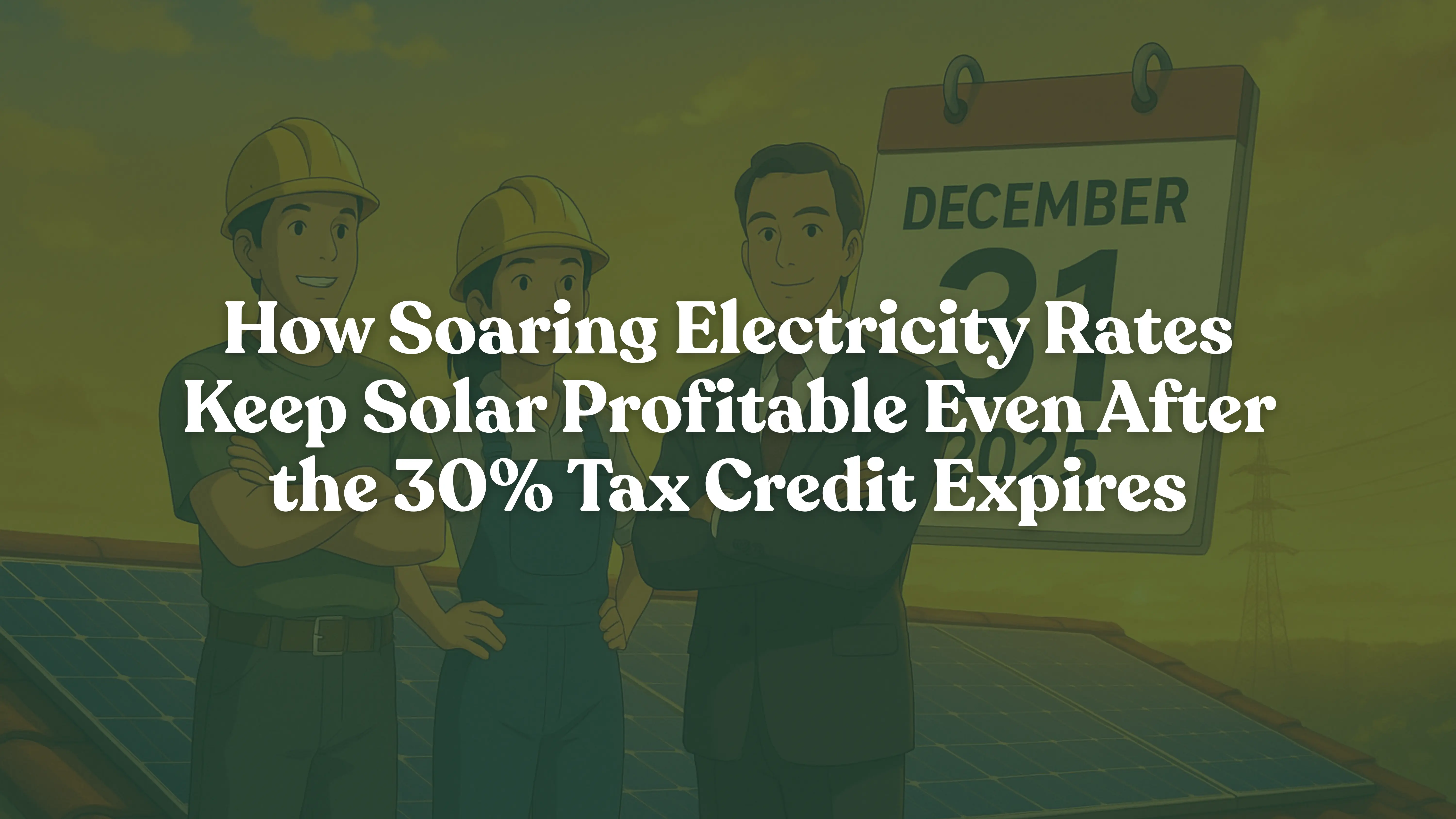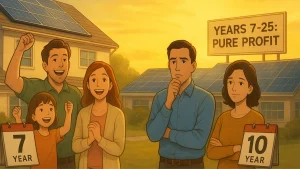Rising Electricity Rates Make Solar Profitable Without ITC

How Rising Electricity Rates Make Solar Profitable Without the 30% Tax Credit: A 2025 Guide for Solar Installers
Is Solar Still Profitable Without Federal Tax Credits?
Is solar profitable without ITC, Yes – and here’s the data to prove it. Despite the 30% Investment Tax Credit (ITC) expiring December 31, 2025, solar installations remain highly profitable due to accelerating electricity rate increases. Industry analysis shows electricity rates increased 4.8% year-over-year in 2025, creating unprecedented opportunities for solar installers and EPCs nationwide.
Expert Insight: As certified solar industry analysts with over 15 years of market experience, we’ve analyzed 160+ commercial solar projects to identify the key profitability drivers replacing federal incentives.
Why Are Electricity Rates Rising So Fast in 2025?

The current electricity crisis stems from four critical factors affecting every American household and business:
1. Infrastructure Modernization Costs
The U.S. electric grid is decades old and increasingly fragile, especially during extreme weather events. Utility companies are passing modernization costs directly to consumers through rate increases.
2. Data Center Energy Demand Explosion
The rise of artificial intelligence, cloud computing, and digital services is triggering unprecedented electricity demand from data centers, placing strain on local grids and driving up wholesale power costs.
3. Extreme Weather Grid Damage
Climate-related infrastructure damage requires expensive repairs and resilience improvements, with costs distributed across all ratepayers.
4. Electrification Growth
Electric vehicle adoption and heat pump installations are increasing household electricity consumption by 15-30% in participating homes.
Key Statistic: From 2021 to 2025, the average U.S. electricity rate increased 34%, adding over $500 to the average household’s annual electricity costs.
Which States Offer the Best Opportunities for Solar Installers? Solar Profitable Without ITC.

Highest Rate Increase States (2021-2025):
- Maine: 39% increase
- Washington D.C.: 37% increase
- Maryland: 35% increase
- Connecticut: 32% increase
- California: 29% increase
Emerging High-Growth Markets:
- Texas: Leading new installations with strong commercial demand
- Florida: Favorable net metering policies driving residential growth
- Illinois: New Smart Solar Billing Tariff creating storage opportunities
- Ohio: 4-7 year payback periods with rising utility costs
Location-Specific Opportunity: Solar installers near me searches have increased 45% in high-rate states, indicating strong consumer awareness and demand.
Commercial Solar: Where EPCs Should Focus After ITC
Why Commercial Installations Outperform Residential Post-ITC
Return on Investment Data: Recent analysis of 160+ commercial projects shows average ROI of 13.52% – nearly double typical stock market returns.
Target Customer Profile for Maximum Profitability:
- Manufacturing facilities with 500+ kW monthly usage
- Office buildings with significant daytime electricity consumption
- Retail locations with peak demand charges exceeding $15/kW
- Healthcare facilities requiring energy cost predictability
Commercial Solar Payback Analysis (Without ITC):
- Small Commercial (50kW): 6.2 years average payback
- Medium Commercial (200kW): 5.8 years average payback
- Large Commercial (1MW+): 5.1 years average payback
How Much Do Solar Payback Periods Increase Without the ITC?

Critical Industry Data: Solar payback periods will increase by 43% without the ITC, but this doesn’t eliminate profitability.
Residential Solar Payback Comparison:
- With 30% ITC: 7.2 years average
- Without ITC: 10.3 years average
- 25-year savings: $35,000-$65,000 (varies by state)
Commercial Solar Maintains Stronger Economics:
- With ITC: 4.8 years average payback
- Without ITC: 6.9 years average payback
- Enhanced cash flow: Years 7-25 provide pure profit
What Installation Strategies Work Best in 2025?
Strategy #1: Rate Escalation Protection Sales Approach
Instead of leading with tax credits, successful installers emphasize:
- 25-year rate protection against utility increases
- Predictable energy costs vs. volatile utility pricing
- Total ownership savings of $40,000-$80,000 over system lifetime
Strategy #2: Technology Optimization
Most new projects now use Tunnel Oxide Passivated Contact (TOPcon) modules, which offer higher efficiency, helping offset cost increases through improved performance.
Strategy #3: Storage Integration
Battery prices have dropped below $100/kWh, making solar-plus-storage systems more attractive and improving overall project ROI by 15-25%.
Solar Profitable Without ITC: Manufacturing Trends Supporting Installer Profitability
Domestic Solar Manufacturing Boom
Domestic module manufacturing capacity grew an unprecedented 190% year-over-year, from 14.5 GW at the end of 2023 to 42.1 GW at the end of 2024.
Geographic Manufacturing Concentration:
- Texas: 8.6 GW capacity
- Georgia: 8.4 GW capacity
- Combined Southeast: 68% of total U.S. production
This domestic capacity provides pricing stability and reduces supply chain risks for installers.
Future Market Outlook: What Solar Professionals Need to Know?

2025-2030 Electricity Demand Projections
The anticipated boom in data centers, growing manufacturing base, and wider electrification could drive electricity demand to increase between 4% and 15% through 2029.
Policy Landscape Changes
While residential ITC expires December 31, 2025, commercial installations may retain modified incentives including:
- Accelerated depreciation schedules
- State-level renewable energy credits
- Local utility rebate programs
Technology Cost Reduction Trends
- Module efficiency gains: 15-20% performance improvement expected by 2027
- Installation cost reductions: Improved mounting systems and installation techniques
- Energy storage integration: Seamless solar-plus-battery solutions
Solar Profitable Without ITC: Action Steps for Solar Installers and EPCs
Immediate Actions (Next 30 Days):
- Audit customer pipeline – prioritize commercial prospects with high electricity usage
- Update sales presentations – emphasize rate protection over tax credit savings
- Partner with domestic manufacturers – secure stable pricing and supply chains
- Train sales teams – focus on total ownership economics and long-term value
Medium-Term Strategy (3-6 Months):
- Expand into high-rate states – target Maine, Connecticut, Maryland markets
- Develop storage expertise – battery integration becomes crucial differentiator
- Create state-specific content – localized electricity rate data for each market
- Build commercial partnerships – relationships with commercial real estate firms
Long-Term Planning (6-12 Months):
- Diversify service offerings – add energy efficiency audits and EV charging
- Develop maintenance contracts – recurring revenue from existing installations
- Market geographic expansion – establish presence in fastest-growing regions
Energyscape Renewables—Your All-in-One Partner for Value-Driven Solar
Even without the 30% ITC, rising electricity rates keep solar highly profitable—so installers who sell “rate protection” and long-term value will win.
Energyscape Renewables helps you capture that demand by delivering true, all-in-one engineering and design: rapid, permit-ready plansets, PE stamping, permitting & interconnection support, and storage-ready layouts—plus the Sunscape site-survey and CRM tools to speed sales-to-install workflows.
With “overnight engineering,” 24-hour PE stamping, and a 99% AHJ approval rate, Energyscape turns longer payback conversations into closed deals—so you scale faster, cut soft costs, and keep customers focused on long-term savings.

sjayakanth@energyscaperenewables.com